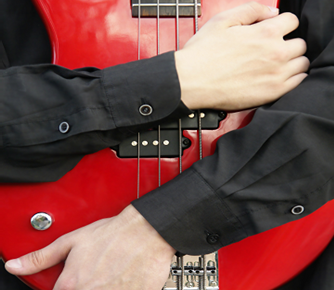Fix Fret Buzzing Problems And Eliminate Noise
 So one day everything is just great; you’re playing bass, your chops have improved, and you’re really getting somewhere. Then you find a cool song you want to learn, but it’s in another tuning. No problem; just tune down, right?
So one day everything is just great; you’re playing bass, your chops have improved, and you’re really getting somewhere. Then you find a cool song you want to learn, but it’s in another tuning. No problem; just tune down, right?
Only when you do, you start getting fret buzz. Easy fix; tune back up. But then when you tune back up, the buzz is still there. What’s worse, the buzz has spread from one fret to three frets.
So How Do You Fix Fret Buzz In Your Bass Guitar?
Before you learn how to fix it, you need to know why your frets are buzzing in the first place.
Well that’s easy, it’s because I lowered my tuning.
Now quite. Fret buzzing is caused by frets rubbing against the fret wire, which in turn dampens the note and causes the buzzing effect. This means one of two things; your action is too low, or your neck is bowed.
Since we were discussing tuning as the source of the issue earlier, we’ll discuss the action problem first. Strings have gauges. Most string gauges (some seem pretty randomly chosen) are set together for a purpose; they work with a specific tuning.
Each gauge gives a certain amount of tension. Each tuning needs a certain amount of tension. This is created by either thicker gauges strings, or higher action. The lower the tuning, the more tension you will need to make the notes ring out properly.
That being said, the best way to discover what string gauges you require for a chosen tuning is to an online string tension calculator. This doesn’t mean that every time you change tunings, you need to change strings though; it means you will need to adjust the bridge to compensate.
Some Technical Information You Should Take Note Of
 The most common string height (measured at the twelfth fret of your fret board) is 5/64”. For bass guitarists who stay in a specific tuning and have proper gauged strings, a height of 6/64” is attainable to compensate for a light touch and allow speed runs to be a bit ‘easier.’
The most common string height (measured at the twelfth fret of your fret board) is 5/64”. For bass guitarists who stay in a specific tuning and have proper gauged strings, a height of 6/64” is attainable to compensate for a light touch and allow speed runs to be a bit ‘easier.’
This means, once you change tuning you should adjust your string height. Although it will not create buzzing, it is also best to re-intonate your bass guitar as well, as the new tuning will throw your old intonation off.
Now let’s say you didn’t change tuning, but picked up your bass guitar to find that your strings are buzzing. Look at your neck from a forty five degree angle. You may notice a slight bend, or bow in it.
This is causing your string to rub the fret wire. To fix the bow, you would simply need to locate your truss rod (it will usually by right behind the nut). If your bass is bowed outwards, which means the middle of the neck is bowed towards the strings, simply loosen the truss rod. If the neck is dipping, simply tighten the truss rod.
As with all tightening, the same rules reply; lefty-loosey, righty-tighty. Never, under any circumstance, turn your truss rod more than a quarter rotation at a time –a little goes a long way, and you risk damaging the neck if you get carried away.
In the end, just be patient, and approach either job carefully. Good luck, and welcome to the buzz-free playing club.
Check Out The Perfect Learning Tool For Bassists of All Skill Levels
JamPlay offers the best online bass instructions on the Internet. With hundreds of professionally recorded lessons, Jamplay is the ideal place to learn the basics and improve your bass playing skills. With great teachers and carefully planned lesson structures, I guarantee you will be able to take your bass playing to a higher level in no time.
Related Articles
Comments are closed.





